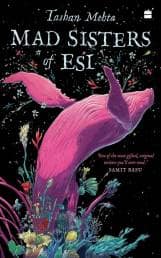



Tashan Mehta’s second novel, Mad Sisters of Esi, is an unusual and immersive work of fantasy that begins with a pair of sisters being torn asunder. Myung and Laleh are ‘keepers of the whale of babel’, spending their lives exploring the infinite ‘cosmic chambers’ therein and documenting what they’ve found. Each world they inhabit has, at least, one door that leads to a new chamber and for Laleh, this never-ending loop of discovery and rediscovery — not to mention her axiomatic faith in a deity called the ‘Great Wisa’ — is plenty to live on. But Myung can’t keep a nagging thought at bay; what if the sisters are not alone? What if there are untold legions of people outside of the worlds they have been exploring, outside of the whale of babel itself? Eventually, this quest leads Myung away from Laleh and fairly early on in the novel, marks her as the designated ‘adventurer’ of these worlds, the Ibn Battuta or Marco Polo-type character.

Myung’s quest also leads her to investigate the true nature of the whale of babel as well as the larger universe (‘the black sea’ as it’s called here). In order to understand these concepts she has to uncover a primordial myth, that of another pair of sisters separated, Magali and Esi. Along the way she and the readers negotiate ‘museums of collective memory’, ‘god machines’, chameleon-like islands, realms whose nature depends on our perception, cartographers and adventurers, deities and pilgrims. Mehta’s writing is elegant and unhurried at the sentence-by-sentence level, and one of the novel’s biggest strengths is how it maintains and develops character even as it regales the reader in a very old-school, fairytale mode. Read this passage, for instance, about Myung getting the hang of the whole explorer-at-sea identity.
“Nothing fazed her. Nothing surprised her. She faced the largest sea monsters with glee. She wrote about the smallest plant with sensitivity and care. She spent years on the wildest islands, decades even, and she tamed them. Myung’s Diaries became gospel. They taught you how to love the black sea, to understand its strange and erratic islands. Sailors read them for instructions; they acted them out for entertainment; they even read them in their spare time, because there really wasn’t much to do on a ship when you had been sailing for ages.”
Is Mad Sisters of Esi a fantasy novel? Certainly, but there’s so much more to unpack here, both form and content. In terms of methodology, the novel has just as much in common with the works of Jorge Luis Borges and Italo Calvino. The fragmentary nature of the book as well as its adroit usage of scientific language recalls the latter’s Cosmicomics, for example, as well as science fiction masters like Isaac Asimov and Arthur C. Clarke, both of whom incorporated academic papers and research documents in their fiction, like Mehta has here.
Similarly, the novel’s ‘whale of babel’ is a concept necessarily linked to infinity as well as linguistic profusion. The Biblical tower of babel was to be built in order to reach the heavens, but God makes it so that the men all start speaking different languages and are hence unable to understand each other; the endeavour is therefore doomed to failure. Borges imagined a ‘Library of Babel’ in an eponymous short story where the seemingly infinite library contained so much information that it left “the librarians in a state of suicidal despair.” On several occasions, the scholars, students and writers Mehta invents here end up being wryly funny in addition to fulfilling their world-building purpose.
“Mirabilia diachronism is an academic discipline that studies how fairy tales change through time. Sailors don’t like it — it is bad luck to tell the sea her stories aren’t true. But cartographers carry oil-skinned books on the subject that they tuck into hammocks below deck and read carefully by candlelight. Much of mapmaking imagery comes from this discipline. The serpents. The monster heads. Submerged islands.”
Notice how the contrasting attitudes of sailors and mapmakers is described here — it’s almost like competing sects of a faith, each convinced in their own immutable, unyielding interpretation of scripture. Academic papers are built on logic and reasoning, while religious or spiritual papers are built on depth of theology or particularly elegant expressions of faith. Mehta’s sleight-of-hand here is collapsing these distinctions between intuition and deconstruction, objective and subjective, finite and infinite. Mad Sisters of Esi isn’t always an easy book to pin down or summarise. But, like the best unconventional novels, it teaches you how to read it from the moment you hop along on the ride. And what an enthralling ride it is.
Discover the latest Business News, Sensex, and Nifty updates. Obtain Personal Finance insights, tax queries, and expert opinions on Moneycontrol or download the Moneycontrol App to stay updated!
Find the best of Al News in one place, specially curated for you every weekend.
Stay on top of the latest tech trends and biggest startup news.